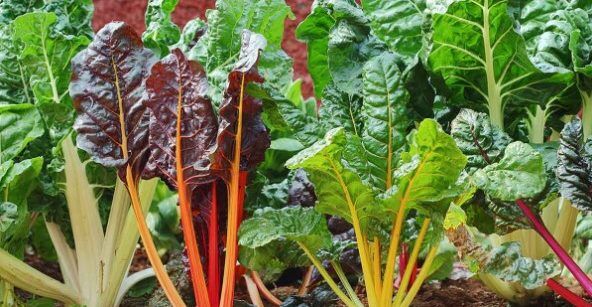Before we let you know if rabbits can eat Swiss chard or not, let us look a little more into this vegetable.
Swiss chard, chard, or Beta vulgaris subsp. vulgaris is a leafy vegetable in the family Amaranthaceae. Its other common names include silverbeet, beet spinach, leaf beat, seakale beet, or perpetual spinach.
Depending on the cultivar, it may have reddish or green leaves while its large stalks may be white, red, or yellowish. Both leafstalks and leaves are edible. You can sauté or stir-fry it, use it soups, or omelets, eat it in a raw salad, and so on. Boiling it makes it less bitter.

Finally, the common cultivars are rainbow (mixed colors), the red-ribbed varieties like Ruby chard and Rhubarb chard, as well as Lucullus and Fordhook.
Can I give Swiss chard to my bunnies?
Yes, rabbits can eat Swiss chard, including the red, rainbow’s, and any other cultivar. However, these pets should eat it in moderations and occasionally.
Chard is an excellent source of vitamin K, vitamin C, vitamin A, magnesium, iron, manganese. Also, it has some riboflavin, vitamin B6, choline, vitamin E, potassium, sodium, phosphorus, calcium, among other nutrients. However, it is high in oxalic acid (oxalates).
It joins other leafy greens like spinach, parsley, mustard greens, beet greens, radish tops, and young sprouts that are high in oxalates.
High oxalates increase the likelihood of your rabbits having calcium uroliths (urinary bladder stones). Furthermore, while in the digestive tract, it may bind with some minerals to reduce their bioavailability, among other effects.
Therefore, when feeding chard to your bunnies, don’t mix it with others that are also high in oxalate. Instead, mix it with turnip greens, spring greens, kale, wheatgrass, watercress, raspberry leaves, cilantro, radicchio, Bok Choy, dill leaves, fennel, mint, basil, arugula, carrot tops, among others that are low in oxalic acid.
How much should they eat?
Since it is high in oxalic acid, it may interest you in knowing how much chard to feed your bunnies. This is a genuine concern. However, the answer is simple. Just mix it with other 4-5 leafy greens low in oxalic acid. A cup of this chopped combination is adequate for a rabbit weighing two pounds.
Keep its frequency low, once or twice a week, and avoid it if your bunnies have urinary bladder stone problems.
Also, ensure the source is free of farm chemicals, don’t cook it and introduce it gradually as you check if it causes any stomach upsets.
Finally, remember that all fresh plant materials should account for only 10-15%, while hay should be unlimited, and high fiber pellets should be 5% of their daily diet.
Conclusion
Swiss chard is ok and safe if you properly feed it to your furry friends. Excessive amounts may cause diarrhea, just like any other veggies since they are low in fiber.
Finally, excessive amounts fed regularly may predispose your rabbis to calcium uroliths.

Thank you for this important information. The leaf stalks have “strings”, like celery has strings. Should the strings be removed before feeding the chard stalks, the same as removing the strings from celery ribs?
Our Bunny is one year and one month in age. At 11 months of age, he experienced GI stasis, and based on what I read it was due to giving treats every day, every feeding. At that time I was feeding Romain, celery, Swiss chard, dill, parsley, mint, and one sliced strawberry, (or six blueberries). A month after his recovery I read, and concluded I was over doing the treats. And possibly over doing the oxalic acid green vegetables.
I was adding two to three large leaves of the Swiss chard, celery with strings. I saw the Two views abdominal x-ray images and his poor abdomen was full of undigested “material”. He weighed four pounds in April, and I have since altered his feedings.
First, fresh hay: Orchard Hay, and Oat Hay, in a combo of two hands full or Orchard Hay to one handful of Oat Hay in the morning and again at night ( if it needs replenishing).
One to one and a half cups of Romain, and green leaf lettuce, added is two or three sprigs of parsley or cilantro, twice daily. To add variety, I add fresh leaves of lemon balm, dill, and mint, one or two leaves of each.
As a treat, I scatter 1/2 teaspoon of Timothy pellets in his hay. He loves these as a treat. I do 1/2 tsp of treat every other night of the last feeding.
For his chewing needs, I have a purchased grass mat. I have rye twists I offer him, but he tosses them away. He is not a fan of apple tree sticks. He will chew a willow ball and a pine cone. Both are pricey and a pine cone from the forest not readily available to me except maybe in fall and winter.
Any suggestions in for chewing would be helpful.
Respectfully grateful,
My Bugs Bunny’s Momma
Southeast Texas.
A rabbit’s diet should have unlimited amounts of grassy such as Timothy, oats, or orchard just like you are doing. It is an important source of balanced nutrients and fiber.
Secondly, keep high fiber pellets to 5-10% of their diet, about ¼ a cup for a rabbit weighing 2-4 pounds and in that approximate ratio. Pellets are a vital part of a rabbit’s diet and not treats. See more on pellets for rabbits
For fresh greens, it is good to mix several varieties and keep varying these types. Give them 2 cups full of a chopped mixture per a rabbit about 4-6 pounds. Ensure you only give them safe leafy greens and vegetables. See good ones at Rabbit Food List.
Finally, keep treats low. Rabbits should not have more than a teaspoon of all types of threats a day. Treats include commercial treats, fruits, and nonleafy veggies like carrots. Keep varying the treats too. See details on rabbit treats.
Additional resources, Rabbit nutritional and diet.